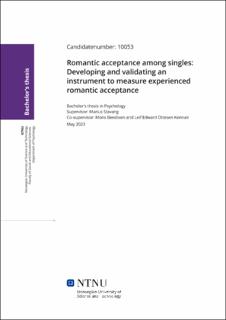| dc.contributor.advisor | Stavang, Marius | |
| dc.contributor.advisor | Bendixen, Mons | |
| dc.contributor.advisor | Kennair, Leif Edward Ottesen | |
| dc.contributor.author | Gabrielsen, Benjamin Skjønvold | |
| dc.date.accessioned | 2023-07-06T17:19:52Z | |
| dc.date.available | 2023-07-06T17:19:52Z | |
| dc.date.issued | 2023 | |
| dc.identifier | no.ntnu:inspera:146342237:99188489 | |
| dc.identifier.uri | https://hdl.handle.net/11250/3076892 | |
| dc.description.abstract | Denne studien søkte etter å skape et valid instrument som gjør det mulig å måle romantisk aksept blant single, ved å utvikle en skala for romantisk-seksuell aksept. Det overordnede målet er at et slikt instrument kan brukes som et valid instrument for å måle romantisk aksept i videre forskning. Det er også et håp at insiktet som kommer av denne studien kan brukes til å forstå romantisk aksept som et fenomen. Spørreskjemaet ble laget gjennom ACT nominasjonsmetoden, hvor forskjellig typer atferd ble laget om til spørsmål i spørreskjemaet vårt. Utvalget bestod av 452 single studenter på NTNU, som svarte på spørreskjemaet. En faktor analyse ga oss en 3-faktoriell struktur, med 13 items. Faktorløsningen sin reliabilitet ble testet gjennom Cronbachs alpha and viste solig reliabilitet. Instrumentets validitet ble testen gjennom en rekke hypoteser. Hypotesene ga blandet resultater, hvor 3 av dem korrelerte i retningen som var predikert, mens de 3 andre ga ikke de resultatene som var predikert. | |
| dc.description.abstract | This study sought to create a valid instrument capable of measuring romantic acceptance among singles, through developing a scale for romantic-sexual acceptance. The overarching goal is that such an instrument can be used as a valid instrument for measuring romantic acceptance in further research. It is also a hope that the insight provided by this study can give insight into romantic acceptance as a phenomenon. The questionnaire was created through the ACT nomination method, where different behaviors were turned into items in the questionnaire. The sample for this study consisted of 452 single students at NTNU, who answered a questionnaire. A factorial analysis gave us a 3-factorial structure, with 13 items. The factorial structure`s reliability was tested through using Cronbach's alpha and showed solid reliability. The instruments' validity was measured through a series of hypotheses. The hypotheses gave mixed results, with 3 of them correlating significantly in the direction that was predicted, while the 3 others did not give the results that was predicted. | |
| dc.language | eng | |
| dc.publisher | NTNU | |
| dc.title | Romantic acceptance among singles: Developing and validating an instrument to measure experienced romantic acceptance | |
| dc.type | Bachelor thesis | |
